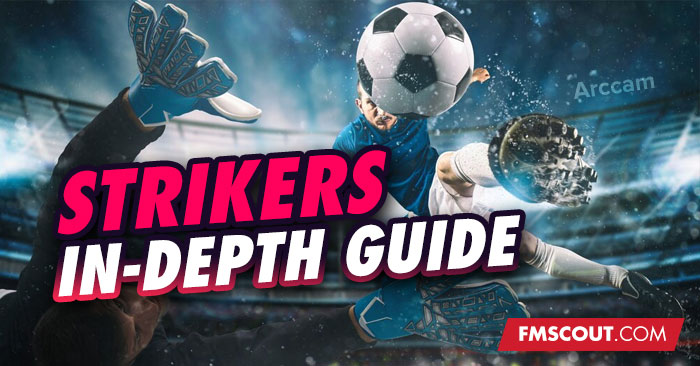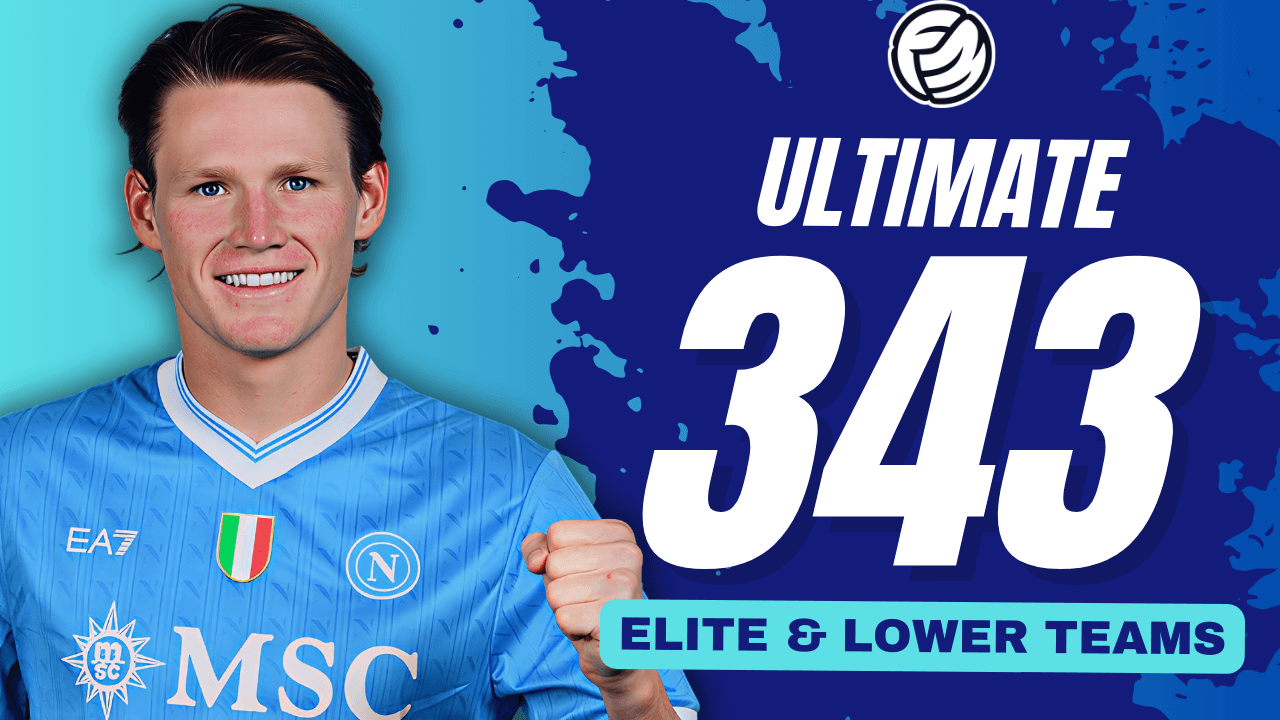
Some time ago, I've gone over classes, and how certain players are in certain classes based on how they play. Before I start going over what striker roles go in which classes, we need to first talk about spaces.
There's lots of space in the field, but for purposes of simplicity I will explain the few spaces you need to be aware off. So there's channels and zones. The Zones are the space in front of the defence and space behind the defence.
The space in front of midfield determines if your team contests possession. It's important to remember that protecting the two zones but not contesting possession leaves you exposed to constant pressure, since you're probably deep and compact.
So there's a balancing act that occurs in football matches, where you have to choose which spaces you give the opponent.
That aside is a tip for your defence but it's also important for understanding strikers. Strikers come in different forms, there is 6 distinct classes they fit into.
Goalscorers (POA)
The first class is the goalscorer class and as the name would suggest they have one job, to bang it in. So you can also understand that they need a select few attributes.The role that encapsulates the goalscorer class is the Poacher. This role has need for few attributes, with their finishing and movement being the most important on the list.
The way in which the goalscorer class succeeds is when the team feeds them plenty of chances. What I mean is that they don't contribute much else, so if they aren't being fed chances, then you might as well be 10 men.
The reality is if you have a player that is a good Poacher, it's because their attributes are stacked in very specific places. It also means they probably aren't very good at actually playing football, rather just striking the ball at goal with feet and head.
Runners (AF)
The next class is the runner class occupied by the Advanced Forward. This role generally wants to run with and without the ball. Needing great mobility, movement as well as the skill to carry the ball at high speeds and the lethality to finish attacking moves.The runners are close to being the most complete strikers in football. Their problem? While they are good at football, they kinda don't do well to find teammates. Not that they can't, they just won't. This limits them should they come up against deep and congested defences.
This role is common for a although eventually it gets shut down. Players who are runners though do have a range of different things on the football field and they fit extremely well into various systems.
They are also very individualistic, building on themselves and their own individual skill so the better they are, the more successful they are even in against congested defences.
Playmakers (F9,TQR)
The playmaker class needs no real introduction, they link play by dropping deep to receive the ball. They change defence to attack in the blink of an eye. Needing a combination of agility, trickery, movement and most importantly passing ability.The False 9 and Trequartista occupy this class, with the TQR being a more aggressive version. The TQR is unique in that their commitment to their role requires them not to engage to much in physical battles.
This makes sense given the likelihood that the player isn't very brave or aggressive. Matter of fact, playmakers class tend to be very good at positioning, that is disturbing passing lanes than they are at actually closing down.
In any case these players are artists and need to be fed the ball constantly. If they keep getting touches, they'll eventually find a pass to unlocks the opponent. It goes without saying that the playmakers do well when played with roles that run ahead of them.
Unlike Runners, they are as good as the system they play in. This suggests that even if they are average, when put in cohesive systems they flourish.
All Rounders (CF)
So this is a hallowed class, with few capable to play in this role. That is the Complete Forward, a role who lives outside the limits of tactical instruction. This role is simply the role you give a player who is good enough to not need further instruction, and if you are blessed with a player adequate a playing this role.It's often because their attributes are extremely high or extremely broad. If it's the latter then you have a player who is very underwhelming but also very consistent. A blessing and a curse, but there are great advantages to all-rounders.
The first is how (on support) they have the same mindset as playmakers to link play, but also the skill to test the keeper from distance. This puts the defenders in a conundrum, close down and leave space for runners or stay where they are and risk conceding from range.
The next is that on Attack, they are similar to the Advanced Forward without that unwillingness to share the ball and with the ability to be an aerial threat like a goalscorer.
Transitional (PF)
This is a class built on hard work, as they are just like runners. They force play with their closing down and chasing of the ball, essentially creating transitions should they force a turnover and making sure to be in the right place to finish of chances.The reason why transitional players are so good is their work to change the complexion of a game. They make a team stronger than it seems, since they will make it difficult for the opponent to keep the ball for long.
This is them having an influence on the neutral game of football. Your team will have more shots and some more possession because of this role. This doesn't mean a lot but it definitely adds up over time. Needing work rate, aggression and a lot of stamina.
This is the transitional class and it really is a class that does well to help your team, particularly defensively. The issue is this class is not really great at putting the ball in the back of the net. Not that they are bad, but if they were excellent at it, they'd be runners or goalscorers.
Instead, they are half decent at it yet probably need to be surrounded by player capable of taking their chances to make up for their inadequacy. Since they influence the neutral game, they are individualistic and are capable of fitting into multiple systems. It therefore goes, they are as good as the individual player.
Controllers (DLF, TM)
A class made for players who want to link and hold up play. Similar to playmaker class but rather than using trickery and mobility to do so. They use physicality. The main reason you'd play a controller over a playmaker is that the controllers are safer.Both classes are good at keeping the ball though controller classes come at cost of some creativity since they have their back turned most of the time. With the controller class not likely to be topping the assist charts.
This isn't much of a problem, as the controller class players still have presence of goalscorers, the Target Man has great physical and aerial ability, so systems can be built on that.
The DLF on the other hand also looks to attack the box late like a runner. This is important because it means they don't need players running ahead of them, rather just players to support them as they lay it off and go forward.
This makes them quite unique. In the sense that they still carry a specific problem not found in other roles. This means in the right system, these roles can be rather strong, even if they are average individually.
Zones
At the start I mentioned the space in front of the defence, the space behind the defence and the channels (which is the space between CB and fullbacks).When a defence is high, it means there's usually little space in front of the defence, but a lot of space behind. It's the opposite with a deep defensive line.
Another key thing to note however is what I said about contesting midfield and how the deeper a team is, they less they can contest for the ball, leading to low possession numbers which inevitable means more shots for the other team.
Often times teams that congest defence, don't have enough players contesting for possession and as such it means there are plenty of chances for your team. When you have plenty of chances, it changes the context of the game.
It's just as important what role or class of striker you have as it is how you go about creating chances for that striker. It's also just as important if you are creating chances at all.
Since it can get really convoluted, we need to simplify it to make sense of it all. For that, we need to classify the classes I just made.
Further classification
Individualistic - Roles that are only as good as the player playing them. They are good for world beaters since they themselves make large and significant differences in the result without any other influence.Goalscorers, Runners and Transitional
The importance of this classification is what it means for your team. Let's assume your team is struggling to keep the ball or is heaving a tough time getting supremacy of the game. If you want to make sure you are a constant threat to any team in a football match, then you need roles that are self concerned.
It also adds the logic that any team that is actively contesting for supremacy is one that is leaving gaps somewhere
If the opposing team is doing a good job contesting midfield, then the individualistic roles are your best bet at keeping a threat at their goal. This is you favouring effectiveness over effeciency, not because you want to be wasteful but because you need to actually start creating and scoring chances.
Systematic - Roles built upon the right formation, roles and team instructions. They can't just be played without serious thought into what everyone else is doing.
All-Rounders, Playmakers and Controllers
If you seem able, capable or are constantly winning the battle for supremacy. That is, you are creating chances, then there's need for some finesse. This means you are making chances at will, you aren't putting them in.
We need to start being more choosy, instead of the first chance we actively look to make the best chance. It's almost always the case that the opposing team has given you supremacy to cover and protect the spaces in their defence.
This is why we need to choose our chances, because if we don't the opposing team will simply let us accumulate a large XG without a single goal. In this sequence, we need the player to focus specifically on scoring as a team.
The outcomes should be in our control, hence why the controller class, the playmaker class and the all-rounder class are best in this situation. They choose their chances!
Talking about Spaces
So with all that being said, we need to understand what scenario a certain striker works and why.Deep and Congested
Often this means little space anywhere, in that case the controller class. The DLF links and attacks the space they create, so it's a good idea to use them against congested defences, particularly if you are playing a possession system.The Target Man on the other hand, when combined with capable crossers, enjoys deep defences since they only really stand in the box and wait for the ball. It's also good for the Poacher, assuming you know there will be not contest of midfield.
Deep and Congested Defence, but you have runners
Assuming you have players in deep positions making runs forward like the CWB or CM(a) or SS then the playmaker class is where you should be looking.The reason is, in this scenario, you want either your False 9 to link with your central runner (MEZ(a), SS(a), AM(a)... etc) or you want them to receive the ball and play a through ball for your wide runner (CWB, W, IW, WB etc...) so that they get to the byline.
The importance of getting to the byline is that the cutback is easier from there and the F9 and other midfielder line up to score. The Trequartista also has this in mind, with the added threat of running through the defence and scoring themselves.
Both the above examples work with the All-Rounder (CF).
High and Uncongested
This is what the Runner loves to play against, the ball is cleared long and they get into a chain dribbling session. Beating one player, then another and another. The issue is they need space for this phenomenon to occur.The alternative is they can just beat the offside line and go and score as well. This is defensive scheme that the goalscore (POA) also enjoys because of the option to beat the offside line.
The AF is the prime counter attacking role and is particularly good at opening up defences that have space behind them or inside their channels (since decongested defence assumes fullbacks will be caught high up).
High and Uncongested, but you have other capable goalscorers
This is made for the Transitional class, as now they are just leveraging the fact other players have the responsibility of being the main strikers. Instead, your striker is focused on stopping the opponent from playing the game so that your team feed the other guys.This is assuming you have roles like the SS, MEZ, IF, AM(a) or even another AF striker or POA. Since these roles are so focused offensively, it goes that they are a defensive liability hence the great need for the services of a transitional player to clean up the game a bit.





![FM26 Data Tweaks [v1.1 | v1.8]](assets/downloads/fm26/fm26-data-tweaks-by-sirtavares-v2.th.png)


![TinyHips' Dark Mode Skin v5.3 [Win + MacOS] *UPDATED 26.1.1 HOTFIX*](assets/downloads/fm26/fm26-dark-mode-skin.th.png)

Discussion: STRIKERS In-Depth Football Manager Guide
No comments have been posted yet..